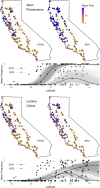Changing patterns of genetic differentiation in the slender wild oat, Avena barbata
- PMID: 36161958
- PMCID: PMC9546611
- DOI: 10.1073/pnas.2121248119
Changing patterns of genetic differentiation in the slender wild oat, Avena barbata
Abstract
The slender wild oat (Avena barbata) was widely studied in California using allozymes in the 1970s and interpreted as a case of ecotypic adaptation to contrasting moisture environments. However, common garden studies suggested that the moist-associated ("mesic") ecotype had high fitness in both moist and dry habitats, thus predicting an adaptive spread into areas occupied by the dry associated ("xeric") ecotype. To test this prediction, we revisited 100 populations of A. barbata that were screened genetically 40 y ago. As expected, mesic allozyme and morphological markers are much more common than in the 1970s. The less-fit xeric ecotype, while still widespread, has declined markedly in range and frequency. Genotyping by sequencing of modern populations reveals striking genetic uniformity within each of the two ecotypes. In recombinants between the two ecotypes, the mesic allele at a major fitness quantitative trait locus (QTL) shows a high frequency but so do many other genomic regions not identified as fitness QTL. Additional introduced genotypes are diverse and more widespread than in the past, and our results show that these have spread into the former range of the xeric ecotype to an even greater extent than the mesic ecotype has. While these results confirm the prediction of contemporary evolution from common gardens, they also suggest that much of the change has been driven by additional waves of introduced genotypes.
Keywords: adaptation; admixture; colonization history; contemporary evolution.
Conflict of interest statement
The authors declare no competing interest.
Figures





References
-
- Hendry A. P., Kinnison M. T., Perspective: The pace of modern life: measuring rates of contemporary microevolution. Evolution 53, 1637–1653 (1999). - PubMed
-
- Reznick D. N., Ghalambor C. K., The population ecology of contemporary adaptations: What empirical studies reveal about the conditions that promote adaptive evolution. Genetica 112-113, 183–198 (2001). - PubMed
-
- Gienapp P., Teplitsky C., Alho J. S., Mills J. A., Merilä J., Climate change and evolution: Disentangling environmental and genetic responses. Mol. Ecol. 17, 167–178 (2008). - PubMed
-
- Heino M., Pauli B. D., Dieckmann U., Fisheries-induced evolution. Annu. Rev. Ecol. Evol. Syst. 46, 461–480 (2015).
Publication types
MeSH terms
Substances
LinkOut - more resources
Full Text Sources
Research Materials
Miscellaneous

